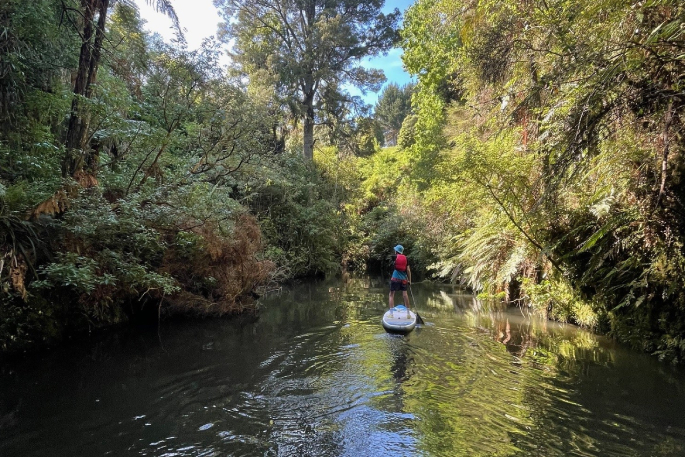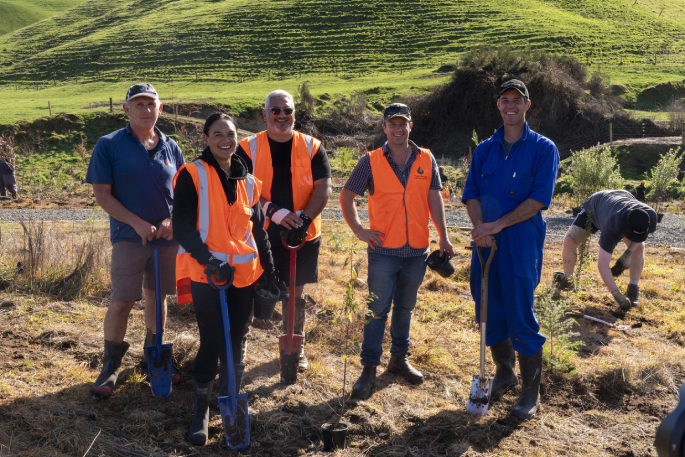Dairy farmers can pick up practical tools and actions to enhance farm waterways at DairyNZ’s Fieldays site this year.
The Healthy Waterways exhibit will give farmers a behind-the-scenes look at how healthy farm waterways support biodiversity and farm businesses, says DairyNZ GM farm solutions and policy Dr David Burger.
Interactive resources cover the science behind riparian planting and what farmers can do to improve water quality and habitat for wildlife – including native birds, eels (tuna), freshwater crayfish (kōura) and other species.
“Water is so valuable to all of us and plays a vital role in ensuring farmers can continue running profitable and sustainable businesses,” says David.
Dairy farmers have made significant progress over the past 20 years to support healthy waterways, and DairyNZ wants to support other farmers to get involved too.
“That’s why we have tested the best ways to enhance water health on-farm to ensure as a sector we continue to progress a positive future for New Zealand dairy farming.”
 Science first: DairyNZ principal scientist Dr Craig Depree contributes to DairyNZ’s evidence-based approach – developing tools and practical solutions that deliver results for farmers. Photo supplied.
Science first: DairyNZ principal scientist Dr Craig Depree contributes to DairyNZ’s evidence-based approach – developing tools and practical solutions that deliver results for farmers. Photo supplied.
DairyNZ water quality specialists will be at Fieldays, sharing technical knowledge and answering questions. “We’re looking forward to sharing our science and farm systems expertise with farmers,” says David.
At Fieldays, farmers can learn more about the benefits of creating shade through riparian planting, which is one of the most effective on-farm actions to create healthy waterways.
Riparian planting helps reduce runoff of nitrogen and phosphate. It also reduces the amount of sediment reaching streams and creates a great habitat for our native species to thrive including fish and insects.
On DairyNZ’s Fieldays site, levy payers can go in the draw to win one of two eDNA kits – a simple way to find out what’s living in a waterway and gain an indication of its overall health.
 Pōkaiwhenua Stream (pictured) is one of the waterways in the Sustainable Catchments programme, which is designed to improve biodiversity and water quality. Photo supplied.
Pōkaiwhenua Stream (pictured) is one of the waterways in the Sustainable Catchments programme, which is designed to improve biodiversity and water quality. Photo supplied.
After taking a water sample in a farm stream, farmers can check their online eDNA report to see data on the health of the waterway, including the wildlife it is supporting – such as plants, insects, fish, seafood and birds.
“Getting a picture of what wildlife is thriving and which species need more support paints a reliable picture of how healthy a waterway is and helps motivate more work to continue improving water quality,” says David.
Visit DairyNZ’s Fieldays site: PC44 in the Pavilion. Go in the draw to win one of two eDNA kits, plus the support of a DairyNZ specialist to help you collect the sample and interpret the results.
The success of DairyNZ’s Sustainable Catchments programme
At Fieldays, farmers can learn more about a community-based Sustainable Catchments programme DairyNZ is co-leading, which brings farmers, iwi and partners together to improve biodiversity and water quality in three priority catchments.
“Catchment work is widely recognised as the way forward in improving the environment, as it achieves better results than a national one-size-fits-all approach,” David says.
 Developing catchment science: DairyNZ freshwater ecologist Dr Belinda Margetts carries out a stream ecology assessment to help inform the Sustainable Catchments programme work. Photo supplied.
Developing catchment science: DairyNZ freshwater ecologist Dr Belinda Margetts carries out a stream ecology assessment to help inform the Sustainable Catchments programme work. Photo supplied.
The work underway covers the Pōkaiwhenua catchment (Waikato), Waimea (Southland) catchment and the South Canterbury region. DairyNZ is working closely to support local landowners and catchment groups, including those who already have water quality improvement initiatives in place.
A key outcome from work by catchment communities is practical tools and activities farmers and others can use to improve water quality. Sustainable Catchments programme funding comes from DairyNZ and the Ministry for the Environment’s Essential Freshwater Fund.
 All hands on deck: DairyNZ scientist Dr Rhiannon Handcock digs in to support healthy waterways. Photo supplied.
All hands on deck: DairyNZ scientist Dr Rhiannon Handcock digs in to support healthy waterways. Photo supplied.
“We’re encouraging farmers to join their local catchment groups or create one. It’s extremely rewarding to get involved in your local community and be part of the solution,” says David.



0 comments
Leave a Comment
You must be logged in to make a comment.